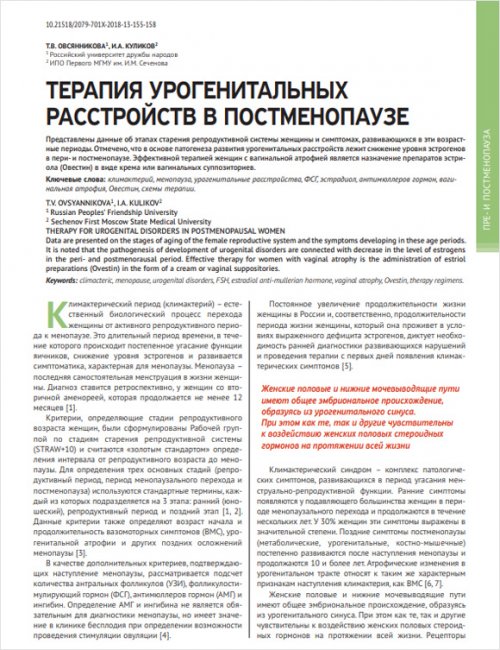Журнал "Медицинский совет. Акушерство и гинекология" №13, 2018
Т.В. Овсянникова1, И.А. Куликов2 1 Российский университет дружбы народов 2 ИПО Первого МГМУ им. И.М. Сеченова
Представлены данные об этапах старения репродуктивной системы женщины и симптомах, развивающихся в эти возрастные периоды. Отмечено, что в основе патогенеза развития урогенитальных расстройств лежит снижение уровня эстрогенов в пери- и постменопаузе. Эффективной терапией женщин с вагинальной атрофией является назначение препаратов эстриола (Овестин) в виде крема или вагинальных суппозиториев.
T.V. Ovsyannikova1, I.A. Kulikov2 1 Russian Peoples’ Friendship University 2 Sechenov First Moscow State Medical University
Therapy for urogenital disorders in postmenopausal women
Data are presented on the stages of aging of the female reproductive system and the symptoms developing in these age periods. It is noted that the pathogenesis of development of urogenital disorders are connected with decrease in the level of estrogens in the peri- and postmenorausal period. Effective therapy for women with vaginal atrophy is the administration of estriol preparations (Оvestin) in the form of a cream or vaginal suppositories.
Загрузить
Список литературы
1. Менопаузальная гормонотерапия и сохранение здоровья женщин зрелого возраста. Москва, 2014.
2. Harlow SD, Gass M, Hall JD et al. Executive summary of the Stages of Reproductive Aging Workshop +10: addressing the unfinished agenda of staging reproductive aging. Climacteric, 2010, 15: 105-114.
3. Avis N.E., Crawford S.L., Greendale G. et al. Duration of menopausal vasomotor symptoms over the menopause transition. JAMA Intern MED, 2015, 175: 513-539.
4. Randolf J, Zheng H, Sower MR, Change in FSH and estradiol across the menopausal transition: effect of age at final menstrual period. J Clin Endocrinol Metab, 2011, 96: 746-754.
5. http://www.statdata.ru/spg_reg_rf.
6. Baber RJ, Panay N, Fenton A. 2016 IMS Recommendations on women’s midlife health and menopause hormone therapy. Climacteric, 2016. 19 (2): 109-150. http://doi.org/10.3109/13697137.2015.1129166.
7. The 2017 hormone therapy position statement of The North American Menopause Society Menopause. The Journal of The North American Menopause Society, 2017, 24(7): 728-753. doi. org/10.1097/GME.0000000000000921. 8.
8. Robinson D, Ioozs-Hobson P, Cardoso L. The effect of hormones on the lower urinary tract. Menopause, 2013.19.155-162.
9. Гинекология. Национальное руководство (под ред. Савельевой Г.М., Сухих Г.Т., Серов В.Н. и др.). М.: ГЭОТАР-Медиа. 2017: 275-284. / Gynecology. National guidelines (under the editorship of Savelyeva GM, Sukhikh GT, Serov VN, et al). Moscow: GEOTAR-Media. 2017: 275-284.
10. Овсянникова Т.В., Макаров И.О. и др. Местная терапия урогенитальных нарушений в пери- и постменопаузе. Акушерство, гинекология и репродукция, 2010, 4(3): 25-28.
11. Балан В.Е., Ковалева Л.А., Тихомирова Е.В. Генитоуренальный или урогенитальный синдром. Возможности длительной терапии. Медицинский совет, 2016, 12: 98-101.
12. Rahn D, Ward RV, Sanses TV et al. Sosiety of Gynecologic Surgeons Systematic Review Group. Vaginal estrogen use in postmenopausal women with pelvic floor disordes. Urogynecol, J, 2015, 26: 3-13.
13. Rees M, Perez-Lopez FR, Ceasul I et al. EMAS clinical guide: low-dose vaginal estrogens for postmenopausal atrophy. Maturitas, 2012, 73: 171-174.
14. Beber RJ, Panay N, Fenton A. IMS Recommendations, Climacteris, 2016.

